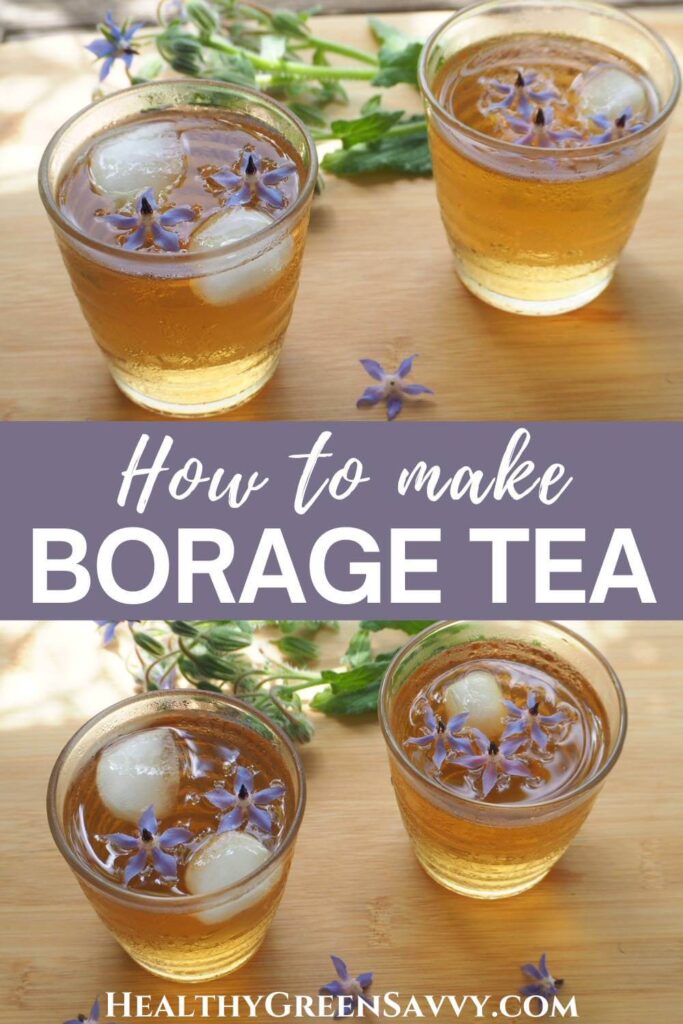Last Updated on February 12, 2024
Have you ever tried borage tea? This refreshing tea is fantastic for cooling you off on hot days. Find out how to make borage tea from fresh or dried borage and pour yourself a cooling glass of this delicious tea.

WHAT IS BORAGE TEA?
Borage is one of those plants that used to be better known but now most folks haven’t heard of it. And that’s too bad, because iced borage tea is one of the most refreshing things you can drink on a hot day.
If you generally drink plain water to cool off, you should give borage tea a try. If you’ve tried and liked cucumber water or mint water, you know that the little addition of flavor — especially when it’s a cooling plant like mint or cucumber — helps you not only drink more, but also feel more refreshed by what you drink.
Borage is among the most cooling herbs I’ve found, and a big glass of cold borage tea is SO refreshing!
You can also drink borage tea hot, where the moistening effects of borage can be pleasant when the air is dry.
Borage also has many useful medicinal properties, making it among the top choices to consider if you want to harvest natural remedies from your yard or medicinal herb garden.
WHY MAKE BORAGE TEA?
Having lots of different options for cooling drinks on hot days makes it easier to stay hydrated in the heat of summer. Add in the fact that borage is a cooling herb, and you get extra help beating the heat.
Borage is one of many wonderful plants we can harvest and brew for tea during the growing season and dry for winter use. It’s astonishing how many options there are! From birch tea to goldenrod tea to ginkgo leaf and hawthorn berry, there are numerous lovely teas we can harvest from our gardens and plants growing wild nearby.
In The Earthwise Herbal Matthew Wood writes, “Borage is a deep-acting nervine suited to cases where there is thorough exhaustion and low spirits.” He cites several other herbalists who recommend borage for those who are run down by overwork and overwhelmed by too many responsibilities, especially in menopause. Along with milky oats, borage is considered useful for supporting the nervous system and recovering from long-term stress.
Borage is also demulcent and anti-inflammatory, and research suggests it’s a source of phenolic compounds. Herbalists sometimes use borage to reduce fever or soothe a sore throat. Borage is among the herbs for cough to keep on hand as well.
Tea made from borage leaves may also work as a remedy for bug bites or sunburn. A poultice of the leaves can also soothe itch and swelling from insect bites.
Want to learn more about using medicinal plants? Check out these top herbal medicine books or the excellent online courses at Herbal Academy.

WHAT DOES BORAGE TEA TASTE LIKE?
Borage tea made from fresh borage leaves and flowers has a very mild flavor reminiscent of cucumber, with a hint of honeydew melon. This flavor will be more prominent if you make a cold infusion rather than steeping borage in boiling water. You can also make it as a sun tea.
I find that tea made from dried borage has far less of borage’s signature melon flavor, tasting more like other neutral-flavored herbs.
The mild, somewhat fruity flavor doesn’t require any sweetener, so try some before adding any sugar or honey. You’ll probably find it doesn’t need it.
CAUTIONS
Like many other plants, borage contains pyrrolizidine alkaloids, compounds that can be toxic in larger quantities. Because of these concerns, it’s advised not to drink large amounts of borage tea over a long period of time, especially if consuming other sources of pyrrolizidine alkaloids.
The occasional cup of borage tea, however, is not considered a problem unless there are underlying health concerns. One study found that whole leaves release fewer of these compounds than crushed ones. You can read more about pyrrolizidine alkaloids here.
Because of concerns with these compounds, it’s generally recommended that pregnant and lactating women as well as children avoid borage. Likewise anyone with a liver condition.
GROWING BORAGE FOR BORAGE TEA
I’ve been growing borage plants in my garden for well over a decade and look forward to their arrival every summer. An excellent self-seeder, borage only needs planting once and then will happily plant itself all over the place for years to come.
So yes, it can become a bit weedy, but it’s very easy to pull. And since it’s great for pollinators and yummy, I’m happy to let it do what it wants. It’s also good at filling in where the soil has been disturbed, so I’ve appreciated its taking care of patches that street work or snowblowers have scraped bare without me having to take the trouble of planting something.
Plus borage is considered a ‘dynamic accumulator,’ which means if it’s growing somewhere I don’t want it, when I pull it out and use it for mulch, it adds nutrients to the soil for other plants to use.
To add to borage’s many benefits in the garden, it makes an excellent companion plant because of its attraction for pollinators and mineral accumulation. It’s also thought to repel pests and improve yields. Borage is one of the best strawberry companion plants and also makes an excellent companion plant for zucchini.
Its pretty edible flowers make lovely garnishes for cakes and fruit salads, and the leaves have a delightful melon-cucumber flavor that’s a fantastic flavoring for homemade seltzer.
–> If you’re still buying seltzer, you can save a ton of money and plastic with one of these wonderful home carbonators. We’ve had ours close to 20 years, and it’s saved us so much over buying bottles and cans, not to mention drastically cutting the footprint of all two decades’ worth of drinks!
To get more of the benefits of borage, though, you’ll want to make borage tea.
WHERE TO GET BORAGE
By far the most economical way to get borage for tea is to grow it yourself. Since it self-seeds readily, you really only need to buy seeds once. You can get seeds from many seed companies, including Botanical Interests, Seeds Now, True Leaf Market, and Eden Brothers.
You can use it fresh during the growing season, and dry some for use during the winter months.
To dry borage, rinse and spin leaves in a salad spinner and lay them on a screen or kitchen towel until they’re dry and crispy.
I highly recommend a collapsible drying screen. I love that it has tons of space for laying out the many different herbs I gather each season but folds up into a small circle that I can tuck away out of season.
I’ve used it to dry huge quantities of foraged Canadian wood nettle, plantain, linden flowers, goldenrod, elderflowers, birch leaves, and so much more.
You can also dehydrate your borage leaves in a dehydrator, using one of the lower temperature settings (around 110 degrees). Here’s more info on dehydrating, a stellar way to preserve tons of your favorite herbs and summer produce.
Once fully dry, you can store borage leaves in an airtight container for up to a year.
If you don’t grow your own, you can get dried borage leaf from Mountain Rose Herbs, a top source of quality herbs. You can also get dried borage from Starwest or from sellers on Etsy.
You might find dried borage flowers for sale at a Middle Eastern grocery or from a few online shops.
USEFUL TOOLS FOR MAKING BORAGE TEA
All you need to make borage tea is borage and hot water, but some helpful tools can take your tea up a notch.
I highly recommend getting a quality water filter. Most water supplies contain scores of unregulated chemicals you do NOT want in your tea, or in anything else you drink. The water quality report you get from your municipality measures just a few contaminants, and most standard water filters do little to remove the many pharmaceuticals and other pollutants common in most water supplies.
Read more about selecting an effective water filter. Note that most popular filters do not filter out most of these chemicals.
Some other tools to help with your tea-making:
HOW TO MAKE BORAGE TEA
You can use both the leaves and flowers in any ratio you choose. The leaves are far easier to pick in the quantities you need for tea, so perhaps save the delicate flowers for more decorative uses, like garnishing salads, adorning cakes or freezing into pretty herbal ice cubes. They also look nice floating in your glass.
A Persian tea called gol gav zaban is made with dried borage flowers, so if you can gather enough, you can produce a pretty purple tea.
For best flavor, I strongly recommend using the cold infusion method. The other methods also make tasty enough teas, but the cold infusion brings out the melon notes best. Definitely also try tearing a few leaves and dropping them in some sparkling water over ice. It’s incredibly refreshing!
Here’s more on making cold infusions from Herbal Academy.
Ready to make some refreshing tea? Find the easy recipe below.

How to Make Borage Tea
Refreshing borage tea is a cooling drink that's perfect over ice on a hot day, or warm in winter for addressing fevers or coughs. The preferred method is cold infusion, but you can also make it with hot water or as a sun tea.
Ingredients
- 1 cup fresh or 2 tablespoons dried borage
- 2 cups filtered water
Instructions
- If using fresh borage, harvest borage leaves and flowers. Herbs are generally at their peak for harvesting in the late morning after the dew has dried.
- Rinse borage and chop or tear leaves.
- Place prepared borage or dried borage leaf in a large teapot or mason jar. Consider using an infuser or muslin cloth to suspend herbs from the top of the jar. As the plant compounds are extracted into the water, they'll sink to the bottom of the jar, creating gentle circulation to help brew your borage.
- Cover with filtered water and allow to steep for 4 to 6 hours.
- Strain and refrigerate what you won't drink immediately.
Variation 1: Sun tea: You can also make a tasty and pretty sun tea using leaves and/or flowers, though the flavor isn't as melon-y as with cold infusion. Place in a sunny location for 6 hours before straining.
Variation 2: Hot infusion: Borage tea can be made hot, but the signature flavor and demulcent properties won't be as well extracted as in cool water. However, it can be ready in much less time. Use 1/4 cup fresh borage or 1 tablespoon dried borage per cup of water and allow to steep at least 15 minutes.
Notes
Leftover tea may be kept in the refrigerator for about 2 days.
EXPAND YOUR HERBAL TEA OPTIONS!
There are so many delicious teas you can make with herbs from the garden or plants you can forage. Below are some of my favorites:
- Lemon Balm Tea
- Pine Needle Tea
- Elderflower Tea
- Dandelion Tea
- Hibiscus Tea
- Mulberry Tree Leaf Tea
- Spruce Tea
Ever tried borage tea? Leave a comment to let us know what you thought of it!
Pin to save this info on how to make borage tea for later!

Disclaimer: I’m a health enthusiast, not a medical professional. Content on this website is intended for informational purposes only and is not meant to provide personalized medical advice. I draw on numerous health sources, some of which are linked above. Please consult them for more information and a licensed professional for personalized recommendations.

Susannah is a proud garden geek and energy nerd who loves healthy food and natural remedies. Her work has appeared in Mother Earth Living, Ensia, Northern Gardener, Sierra, and on numerous websites. Her first book, Everything Elderberry, released in September 2020 and has been a #1 new release in holistic medicine, naturopathy, herb gardening, and other categories. Find out more and grab your copy here.









 Hi, I'm Susannah, a garden geek, energy nerd, and fan of healthy food and natural remedies. Need some simple, practical solutions for living healthier and greener? You've come to the right place! More about me and my green projects
Hi, I'm Susannah, a garden geek, energy nerd, and fan of healthy food and natural remedies. Need some simple, practical solutions for living healthier and greener? You've come to the right place! More about me and my green projects
Leave a Reply